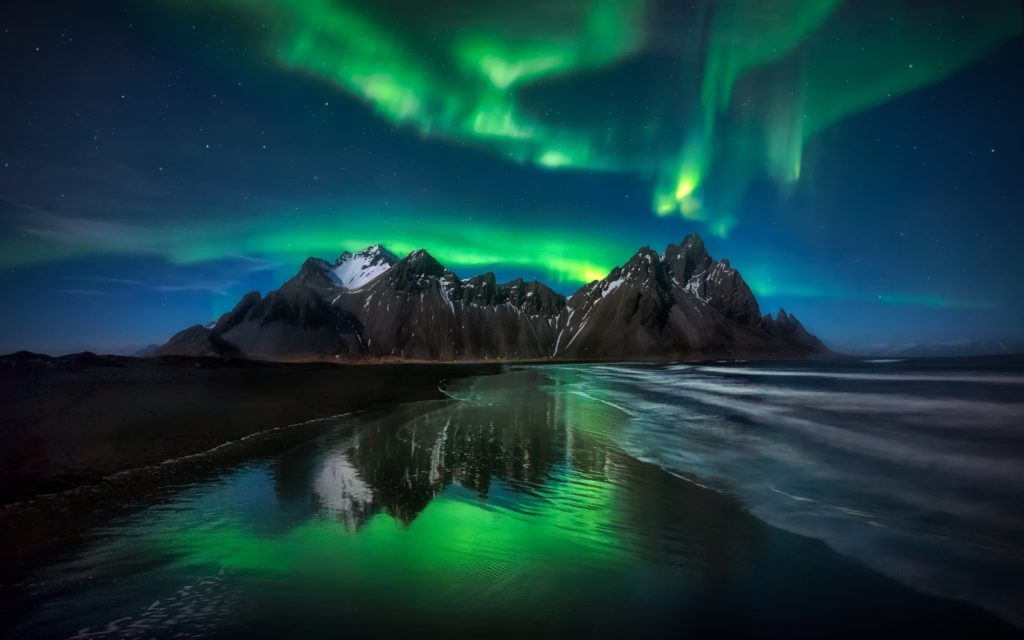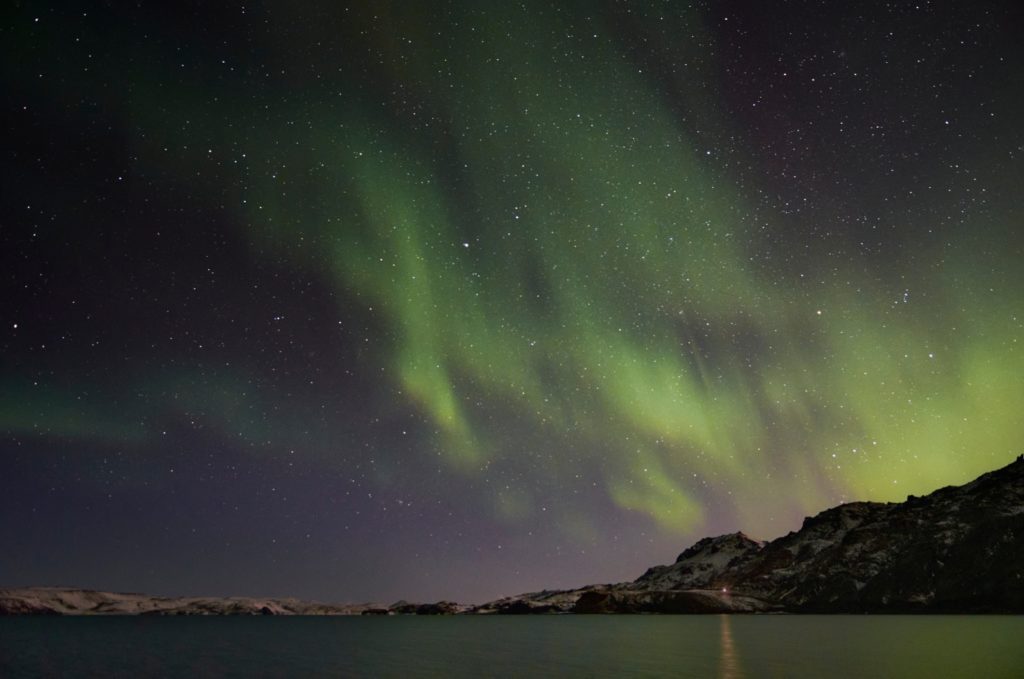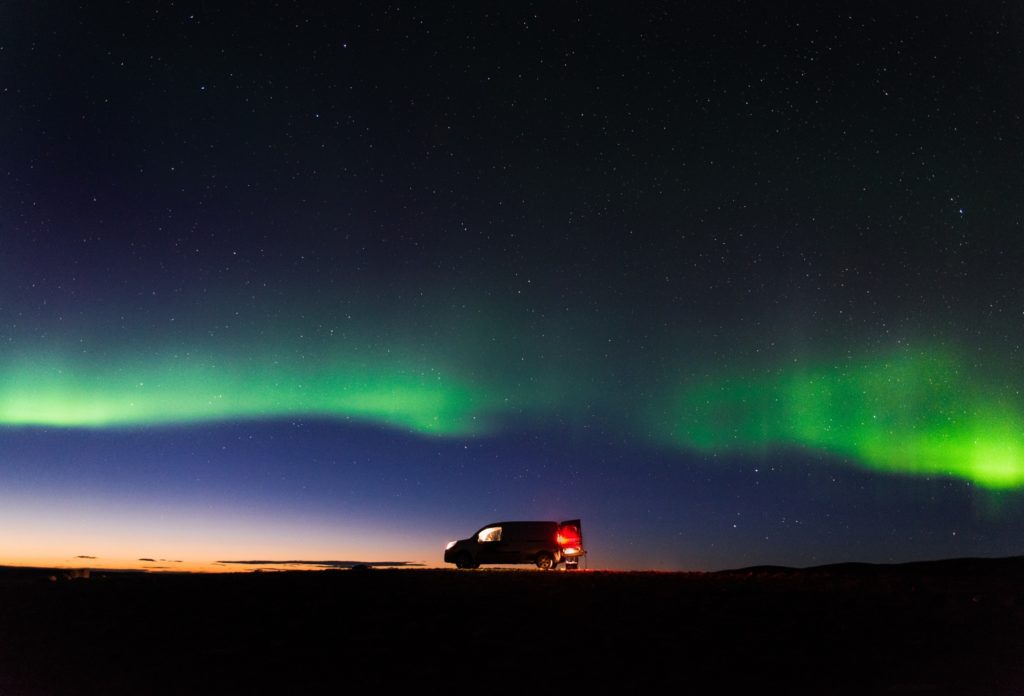The Northern Lights – or Aurora Borealis – is a breathtaking natural phenomenon that illuminates the night skies of Iceland for over seven months of the year.
This Holy Grail of skywatching is on more travel bucket lists than anything else.
While Iceland is one of the best places in the world for witnessing this spectacular act of nature – drawing thousands of visitors every year – nature can be fickle, and seeing the Northern Lights during your visit can never be guaranteed.
However, with careful planning, patience (and a little luck), you can maximize your chances of experiencing these magnificent light displays and creating memories that will last a lifetime.
Here we offer seven top tips to help you do just that.
1. Choose the right time of year
Technically, the Northern Lights are active throughout the year, but it’s highly unlikely that you’ll get to see them during the summer months, as there just aren’t enough hours of darkness. The aurora zone can experience up to 24 hours of daylight from April through August.
Therefore, the peak viewing season in Iceland is always September to April when there is the perfect combination of prime weather conditions and long, dark nights.
In addition, solar activity is usually strongest around the fall and spring equinoxes, offering the best chance of seeing an aurora storm.
The autumn equinox of 2022 is on 22 September, and the spring equinox of 2023 is on 20 March.
2. Pay attention to the conditions

To increase your odds of witnessing the Northern Lights in all their glory, the following conditions are essential:
- Darkness. To view the most intense and vibrant displays, the sky should be as dark as possible, away from the light pollution of populated areas. You’ll also need to consider the phase of the Moon and avoid the full Moon. The best viewing time is typically between 10 pm and 2 am (local time).
- Clear skies. As the magical waves of colorful light occur above the clouds in the Earth’s atmosphere, any cloud cover will seriously interfere with your viewing. Therefore, check the weather conditions on the Iceland Met Office website before you head out to explore, to avoid disappointment.
- High aurora activity. Several websites offer an activity forecast, including Aurora Forecast. The Kp-index forecast is measured on a scale of 1–9. Anything above a 3 indicates a good chance of seeing the dancing lights across a clear night sky.
3. Select the ideal location and viewing spot
When aurora activity is high, and the conditions are favorable, you can see the Northern Lights from almost anywhere in Iceland. However, there are locations that offer a front-row seat with clearer and more vibrant viewing.
The key is to find remote locations within the auroral zone with little or no light pollution, good sky visibility, and no cloud cover. The further north you travel, the greater the opportunities.
Around Reykjavik
If you’re staying in the capital, it’s advisable to avoid light pollution and instead drive out to the surrounding countryside. This will increase your chances of light-hunting success.
The five favorite spots with visitors are:
South & East Iceland

As the most visited part of Iceland, locations in the south are more easily accessible and provide a good option for those hoping to view the Northern Lights. While the east is the least-visited region, it still has plenty to offer and can be a perfect place to go aurora hunting away from the crowds. Popular locations include:
- Reynisfjara Black Sand Beach
- Jökulsárlón Glacier Lagoon
- Seljavallalaug
- Skogafoss Waterfall
- Kleifarvatn Lake
North & West Iceland
Being closer to the Arctic Circle, the north, in particular, offers extended hours of darkness through winter and typically less cloud cover.
This makes it ideal for finding top Aurora Borealis viewing spots, including:
- Asbyrgi Canyon
- Godafoss Waterfall
- Arctic Henge
- Kirkjufell
- Siglufjördur
Iceland’s Northern Lights hotels also offer a range of fabulous options if you prefer to enjoy the magical spectacle of the lights from the comfort of a glass-domed bedroom, hot tub, or geothermal pool. However, remember that if you are in one fixed location, your chances of seeing the Northern Lights will be limited.
4. Tap into local knowledge and expertise
According to the locals, a guided tour is one of the best ways to increase your chances of seeing stunning light shows. Local tour guides are typically skilled ‘hunters’ of the Northern Lights and experts in finding the best locations in the right conditions.
You can, of course, rent a car and drive out on your own nighttime adventures. Tap into the local knowledge to check the weather forecast, aurora activity, and road conditions before you set off. Also, ensure your rental car has studded tires during the winter months and opt for a 4-wheel drive if available.
Self-drive is not advised during the winter months in Iceland if you have limited driving experience in icy/snowy conditions in rural areas.
5. Be flexible and ready to head out at a moment’s notice
Despite how well you prepare for your Northern Lights trip, nature is typically unpredictable, so you’ll need to be as flexible as possible once you arrive.
One of the best ways to avoid missing a spontaneous burst of activity in the night skies is to use a live tracking website or app to receive push notifications – and be ready to set off on your adventure at a moment’s notice. Options include:
- Hello Aurora
- Aurora Forecast
- Soft Serve News
- SpaceWeatherLive
- My Aurora Forecast
- Icelandic Met Office
Similarly, if you’re staying in one of Iceland’s Northern Lights hotels, you can book a personal wake-up service during the winter season so you don’t miss out on your much-anticipated aurora experience because you’re asleep!
6. Be patient

Solar activity can be sporadic. The magnificent light displays usually appear in short bursts of 15–20 minutes at a time.
So, to increase your chances of seeing nature’s dazzling light shows you’ll need to be patient – and, potentially, be prepared to stay up all night gazing at the sky!
7. Extend your stay
Even if the conditions seem perfect, seeing the Aurora Borealis is still a game of probability requiring a degree of luck. However, to beat the odds during your visit to Iceland, you should aim to extend your stay for as long as possible.
Booking a trip for a week or more will definitely present far more opportunities to witness this light show of a lifetime.
The Aurora Museum, Reykjavik
While following our top tips should significantly improve your chances of seeing the Northern Lights in Iceland, there’s never a 100% guarantee with natural occurrences.
If you’re unlucky, you can always take the edge off your disappointment by visiting the Aurora Museum in Reykjavik. It has an engaging multimedia exhibition, interesting interactive displays, and impressive virtual reality glasses.
If you’re interested in learning more about the Aurora Borealis, you can also visit the Northern Lights planetarium experience at the Perlan Museum in Reykjavik. Here you can virtually travel through time and space to see how the lights are formed and get to experience them in new ways.
Whether you see the lights during your trip or not, these two museums are still well worth a visit.
We hope these tips have inspired you to start planning your trip to Iceland to witness one of the most awe-inspiring natural phenomena in the world.
If you’d like more local information and guidance about the Northern Lights or need to book a car, do please contact us and we’ll be happy to help.
Keep reading our blog for more travel tips and ideas for visiting the beautiful island of Iceland.
Back